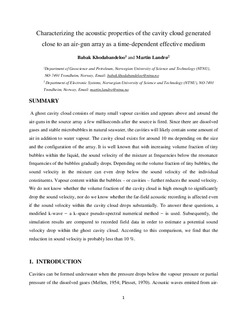| dc.contributor.author | Khodabandeloo, Babak | |
| dc.contributor.author | Landrø, Martin | |
| dc.date.accessioned | 2019-02-11T13:50:00Z | |
| dc.date.available | 2019-02-11T13:50:00Z | |
| dc.date.created | 2018-10-30T11:20:51Z | |
| dc.date.issued | 2018 | |
| dc.identifier.issn | 0956-540X | |
| dc.identifier.uri | http://hdl.handle.net/11250/2584832 | |
| dc.description.abstract | A ghost cavity cloud consists of many small vapour cavities and appears above and around the air-guns in the source array a few milliseconds after the source is fired. Since there are dissolved gases and stable microbubbles in natural seawater, the cavities will likely contain some amount of air in addition to water vapour. The cavity cloud exists for around 10 ms depending on the size and the configuration of the array. It is well known that with increasing volume fraction of tiny bubbles within the liquid, the sound velocity of the mixture at frequencies below the resonance frequencies of the bubbles gradually drops. Depending on the volume fraction of tiny bubbles, the sound velocity in the mixture can even drop below the sound velocity of the individual constituents. Vapour content within the bubbles—or cavities—further reduces the sound velocity. We do not know whether the volume fraction of the cavity cloud is high enough to significantly drop the sound velocity, nor do we know whether the far-field acoustic recording is affected even if the sound velocity within the cavity cloud drops substantially. To answer these questions, a modified kwave—a k-space pseudospectral numerical method—is used. Subsequently, the simulation results are compared to recorded field data in order to estimate a potential sound velocity drop within the ghost cavity cloud. According to this comparison, we find that the reduction in sound velocity is probably less than 10 per cent. | nb_NO |
| dc.language.iso | eng | nb_NO |
| dc.publisher | Oxford University Press | nb_NO |
| dc.title | Characterizing the acoustic properties of the cavity cloud generated close to an air-gun array as a time-dependent effective medium | nb_NO |
| dc.title.alternative | Characterizing the acoustic properties of the cavity cloud generated close to an air-gun array as a time-dependent effective medium | nb_NO |
| dc.type | Journal article | nb_NO |
| dc.description.version | submittedVersion | nb_NO |
| dc.source.pagenumber | 545–559 | nb_NO |
| dc.source.volume | 216 | nb_NO |
| dc.source.journal | Geophysical Journal International | nb_NO |
| dc.source.issue | 1 | nb_NO |
| dc.identifier.doi | 10.1093/gji/ggy449 | |
| dc.identifier.cristin | 1624851 | |
| dc.relation.project | Norges forskningsråd: 228107 | nb_NO |
| dc.relation.project | Norges forskningsråd: 228400 | nb_NO |
| dc.description.localcode | This is the authors' manuscript to the article. The version of record is available online at: https://doi.org/10.1093/gji/ggy449 | nb_NO |
| cristin.unitcode | 194,64,90,0 | |
| cristin.unitcode | 194,63,35,0 | |
| cristin.unitname | Institutt for geovitenskap og petroleum | |
| cristin.unitname | Institutt for elektroniske systemer | |
| cristin.ispublished | true | |
| cristin.fulltext | preprint | |
| cristin.qualitycode | 2 | |
